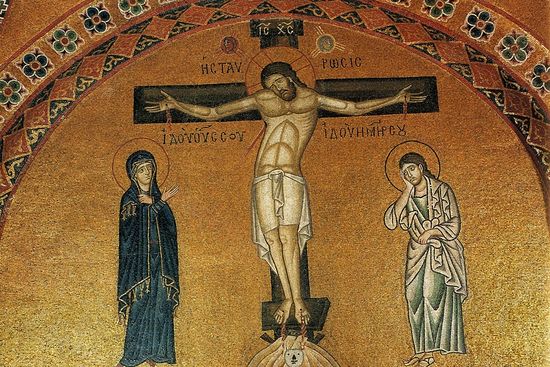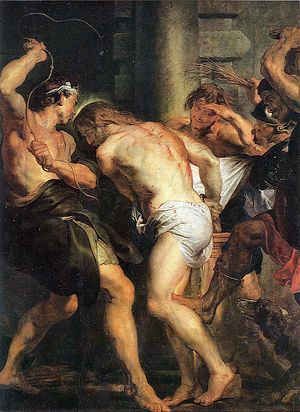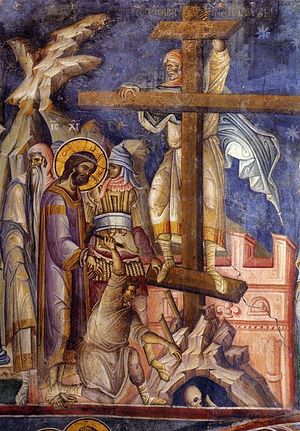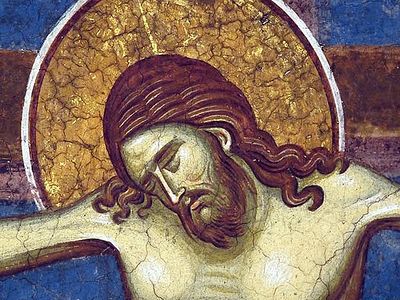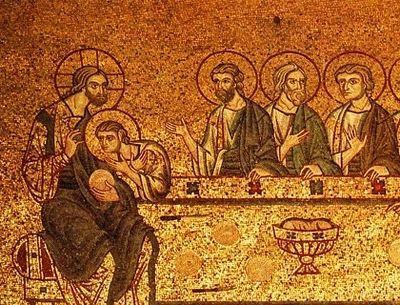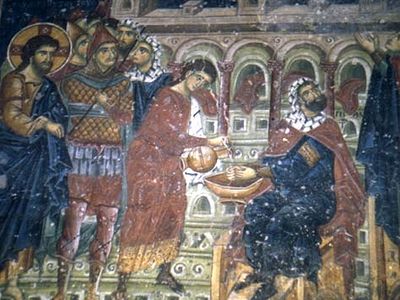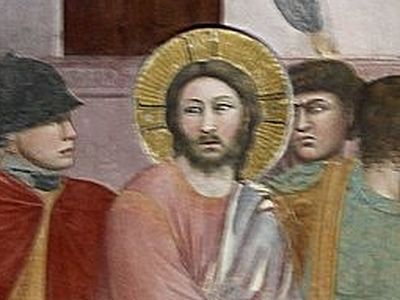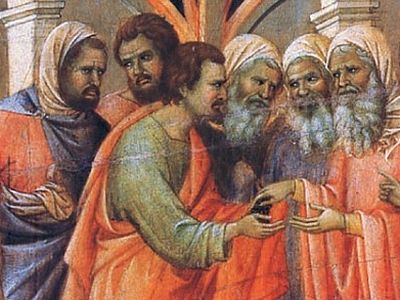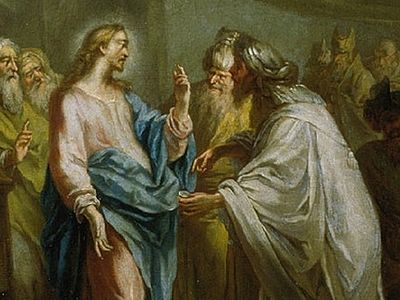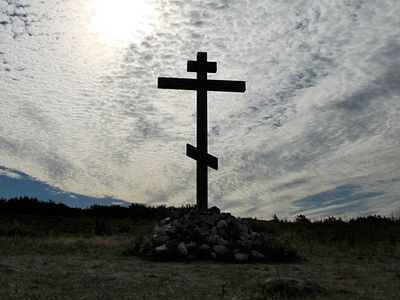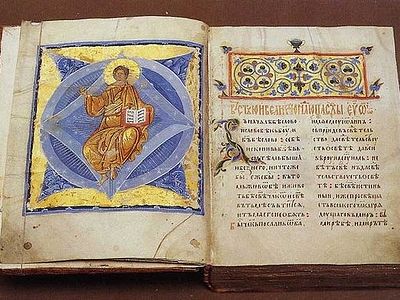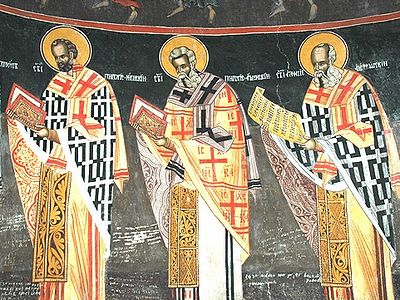We have reached the lesson on the Crucifixion. I will be talking to you today about the history of the Crucifixion, what it entailed, as well as some of the spiritual insights the Fathers have for us on the Crucifixion. For those of you who like the Fathers, there are going to be lots of quotations from the Fathers in this lesson, and I will be doing some explanation from details in the Gospels about the Crucifixion of Christ.
I will be using quite a few quotes from the Fathers today, including quite a number from Augustine. If you’re new to this podcast and if you’re an Orthodox Christian not accustom to hearing Augustine quoted, as I explained in an earlier podcast, I think it’s appropriate to quote Augustine, and if you want to know why you can listen to the fourth podcast lesson [third transcription.—O.C.] in this series of Search the Scriptures for an explanation of why I’m using Augustine. I will tell you that all of the quotations you will hear from Augustine today come from his various sermons, not from his theological works, so the sermons are where you’re going to find some very inspiring statements by St. Augustine.
Did the Jews have the right to kill?
Another question: People often wonder (and somebody wrote in to ask me about this) how it is that the Gospels report that the Jews took Christ to Pilate because they did not have the right to execute anyone? And yet we know that St. Stephen was executed (in Greek Stephanos, that’s why I usually refer to the first Christian martyr as Stephan even though it’s commonly pronounced “Steven”). So St. Steven or St. Stephan is called the protomartyr because he is the very first Christian martyr. We know that he was executed by the Jews. For this reason many people doubt the accuracy of the Gospel accounts; but the Gospels are accurate. The Jews did not have the right to kill someone. They didn’t have the right of capital punishment. That right was reserved by the Romans, with one exception that I know of: They had the right to kill any Gentile who entered the Temple. And this is why when St. Paul enters the Temple, in the book of Acts, a riot almost breaks out—because they believed that Paul had brought a Gentile into the Temple, and Paul is arrested for this.
We know that there were signs in Hebrew, Latin and Greek on a wall that surrounded the outside of the Temple building itself, warning Gentiles not to enter the Temple on penalty of death. It is told to us by Josephus, and by Philo of Alexandria, another first century Jewish writer. In recent years one such sign was actually discovered, so we know that they could kill people for that one narrow exception. But that didn’t happen very often.
So why was St. Stephan stoned to death? If you look at that case in the book of Acts you’ll see clearly that this was a mob action. They did not have the right to kill him, but he was preaching, and as he was preaching he talked about the Lord. And what he said about Christ was so offensive to the Jews who were listening that they believed he committed blasphemy; it tells us that they stopped up their ears, rushed at him, and grabbed him and took him outside the city where they stoned him to death. We also see in the Gospels many attempts to arrest Christ; and people wanted to stone Him to death right on the spot, right? What about the adulterous woman? They brought her to Christ, and they were threatening to stone her to death.
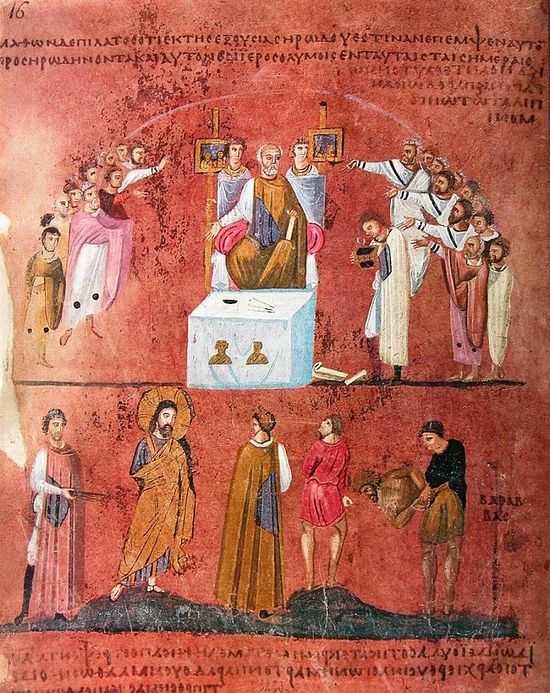 Holy and Great Friday. The Jews demand Christ's death: "Crucify Him!" 6th c. Miniature from the Rossano Gospels. Rosano museum, Italy.
Holy and Great Friday. The Jews demand Christ's death: "Crucify Him!" 6th c. Miniature from the Rossano Gospels. Rosano museum, Italy. Thus, even though it was illegal there were times when people reacted violently and would stone someone to death if they felt it was warranted, but that didn’t make it legal. In the case of Christ, they wanted Him executed legally, and that’s why they took Him to the Romans. It was for a couple of reasons. They wanted Him executed legally to absolve themselves of responsibility for His death; and, the Jewish leaders also wanted Him executed by crucifixion to totally discredit and humiliate Him, to prove without a shadow of a doubt that He was cursed by God and a false prophet. You will see why that’s the case during this lesson when I explain to you precisely what crucifixion entailed.
So let’s begin with our prayer: “In the name of the Father, and of the Son and of the Holy Spirit. Amen. Illumine our hearts, O Master Who loves mankind, with the pure light of Thy divine knowledge and open the eyes of our minds to understand Thy Gospel teachings. Implant in us also the fear of Thy blessed commandments, that trampling down all carnal desires, we may enter upon a spiritual manner of living, both thinking and doing such things that are well-pleasing to Thee. For Thou art the illumination of our souls and bodies, O Christ our God, and to Thee we ascribe glory, together with Thy Father, Who is from everlasting, and Thine all-holy, good, and life-giving Spirit, now and ever and unto the ages of ages. Amen.”
The Lord came to His passion willingly
Well, the first thing that I want to tell you about is how important it was to the Fathers of the Church to emphasize that the Lord came to His passion willingly, and I want to share with you a couple of quotes about this. St. John Chrysostom said, “It was to teach us this lesson, (that is, not to fear death) by His example, that Christ went to His Passion; not by compulsion or by necessity, but willingly.” And St. John of Damascus also said: “With Him, nothing is found to be done under compulsion. On the contrary, everything was done freely. Thus, it was by willing that He hungered, and by willing that He thirsted, and by willing that He was afraid, and by willing that He died.” Thus, it’s common for the prayers of Holy Week to speak of the Lord’s “voluntary Passion,” and that’s why they emphasize this so much. It’s so important to note that Christ did this: He consented, He deigned to be crucified. It was a sign of His great condescension to be crucified.
What was crucifixion?
Let’s begin talking about what crucifixion was. Where did it originate? It is said that it originated among the Babylonians and others say among the Persians, around the sixth century B.C. It was later adopted by others, unfortunately, and of course the Romans used this as their preferred method of execution for those who were not Roman citizens. Originally people were literally crucified on trees. They didn’t have to build a cross. They just found a tree, affixed the person to the tree trunk and their arms to the tree branches. This is another reason why the cross is sometimes called “the tree.” Later, actual crosses were constructed for this form of execution. It was considered the most painful and the cruelest of all punishments, the very worst form of punishment Rome had. It was slow, painful and humiliating. We get our word for the worst kind of pain, the word “excruciating,” from this idea. “Excruciating” means “out of the cross.” That’s a Latin for pain that is so bad that it can only be compared to crucifixion. It was a punishment reserved for the worst offenders of society, those who did not deserve to die with even a shred of dignity. It was a form of death so debasing, so revolting and so shameful that we cannot really comprehend how it was perceived in the Roman Empire to say that your Savior, your God, your Messiah died on a cross. For this reason Paul says, “I am not ashamed of the Gospel,” even though “We preach Christ crucified.” He speaks of “the scandal of the cross.” This is an understanding which we have lost, dear brothers and sisters, because we grow up knowing that Christ was crucified. It doesn’t shock us. But it was a shocking and a scandalous death, a death so scandalous, that a Roman citizen could not legally be crucified, for to do so would be to degrade the glory of Rome itself. Only Roman subjects, not citizens, were crucified. If you’re wondering, women were also crucified, but they were crucified facing backwards, they faced the wood, and I think perhaps the reason for this was because the person was crucified naked, absolutely stark naked, and this was done to add to their humiliation. Now in case you’re wondering about Christ, He was not crucified completely naked because in Judea, because of Jewish law, because of Jewish modesty, the condemned person was allowed to wear his undergarment and this is what we see in the icons and paintings of the Crucifixion. So, Christ was not crucified naked, but most people were. We have many saints of the Church who were crucified. St. Peter and St. Andrew were crucified. They were not in Judea when they were crucified, so they suffered a very painful, humiliating death; they were entirely naked, and they probably spent many hours if not days on their crosses.
Crucifixion was a very public event. One of the things I didn’t like about the Mel Gibson movie, this particular detail that was incorrect, was the fact that it showed the place of execution far, far outside of the city. It’s a beautiful scene on a nice rocky hill, but the city is miles away, far in the distance. But in fact, crucifixions took place just outside the city walls. First of all, there’s no reason to take the criminals miles away just to kill them. It was definitely done outside the city because it was considered that to die, to be executed, was a curse, and they didn’t want to stain the city with blood. They didn’t want the city itself to be cursed by the blood of a condemned person. That’s why it tells us St. Stephan was taken outside the city and stoned to death. They didn’t do it right there within the city walls. But the crucifixions also took place outside the city and on the main road leading into the city–whatever city it was–to make a statement, so everyone could see what would happen to anyone who committed a crime or challenged the authority of Rome. It was like advertising. You want to place your billboard next to a busy highway where everyone can see it, and Rome was making a statement.
So, there was a theological reason why crucifixion and other kinds of executions took place outside city walls: They didn’t want to stain the city with the blood of a condemned person, because that blood was like a curse, and they didn’t want to curse the city. Of course, there was also a practical reason: They wanted people to see what happened. In the American West, the same thing happened with hangings. Hangings were public events. Everyone would go to see them.
Today, the site of the Crucifixion is within the city walls because after the time of Christ, the city of Jerusalem was expanded and new walls were constructed. So, the Church of the Resurrection, which contains both the tomb of Christ and the site of the Crucifixion, is within the city walls of Jerusalem today. But at the time of Christ it was outside the city walls, and the fact that Christ died outside the city was also seen as fulfillment of prophecy. Remember that parable that we discussed, the parable of the wicked tenants who take the son of the owner of the vineyard outside the vineyard to kill him?
After being condemned to death by the Roman governor, the crime committed was inscribed on a placard, a small sign called a “titulus.” Christ’s sign said “The King of the Jews,” and the Jewish leaders protested to Pilate. They didn’t want it to say, “The King of the Jews.” They wanted it to say “This man said He was the king of the Jews,” but Pilate purposely had it say, “The King of the Jews.” He was really “sticking it” to the Jewish leaders, (retaliating against them.) He was angry with them for forcing him have Christ crucified and he is doing that on the sign on purpose. The Fathers of the Church also noted that.
The Roman scourging
So, first He was condemned, a placard was drawn up, but also prior to Crucifixion the condemned person was usually scourged. I told you in the previous lesson that a Roman scourging was different from a Jewish flogging or whipping. The instrument used by the Romans was not the smooth, calf-skin whip of the Jewish flogging, but a different kind of instrument called the flagellum. The flagellum was a whip that had several strands that branched out at the end, and at the end of these strands were metal balls and pieces of sharp metal or bone. The metal balls would strike the person’s back and as if tenderize the flesh, and those sharp pieces of metal would dig into the person’s flesh. When the Roman soldier pulled it out it would take a bit of flesh with it. So when the flagellum struck the condemned man, with each strike he received many, many serious wounds. You can see how this was different from the one strand of calfskin whip. The scourging was extremely serious; it was easy to die from the scourging. Not only did the flagellum—the strands—actually hit the person on his back, it could also wrap around and strike them on their abdomen, and it was not uncommon for the entrails of the person to become exposed and their organs to be seen.
Now much was made of the realism of the Mel Gibson movies, especially the scourging scene. First of all, in the movie, he [Gibson] also has the Lord beaten with rods before the scourging. That didn’t happen. I don’t know why they felt compelled to add things that are not in the Gospels. The scourging was enough.
I was a little bit afraid because I know how bad scourging really was, but when I saw the movie it was not as bad as I thought it would be, because even though it was more violent and at least more bloody than previous movies, it was not as bad as a real scourging would have been. A real scourging was much, much worse than what the movie showed. A real scourging would have left the condemned person’s back basically a bloody pulp, the muscle was shredded by these pieces of metal that tore into the flesh and then the soldier would have to pull it out. Many people could die from the scourging alone, but the Romans had become experts in administering this type of punishment and they didn’t want the person to die before he was crucified, so they knew how far to push it to make sure that they actually would have the opportunity to be crucified.
I also told you that the Gospels do not tell us how many scourgings the Lord received. There is in fact no mention of 39 lashes in the Gospels. That was a limit under Jewish law for a flogging; that’s a Jewish whipping. But this was a Roman scourging. There was no limit and as I told you before I’m convinced that the Lord received a terrible scourging, much worse than the ordinary. If He had not already been flogged by the Jews with a whip, He had a very, very severe scourging. You see the other things that were done to Christ: The mocking, the striking of Him, the crown of thorns—those things would not have hastened His death. But the fact that He dies after only three hours on the cross shows that He endured a very intense suffering prior to the crucifixion in this scourging, because the Lord was a young man. He was strong, He was healthy, people generally hung on the cross for many, many hours before dying; and you see this because the Gospels tell us that Pilate was surprised to learn that He was already dead. So that gives you an indication of how much the Lord suffered in the scourging. It’s really unimaginable for us.
Carrying the Cross
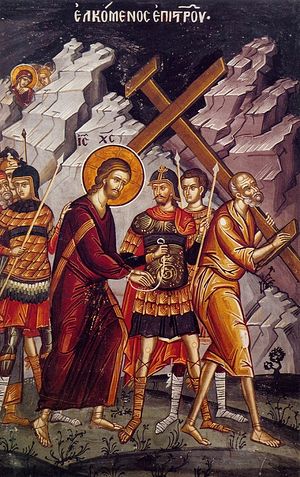 Holy and Great Friday. The Lord walks to His suffering. Fresco in Stavronikita Monastery, Mt. Athos.
Holy and Great Friday. The Lord walks to His suffering. Fresco in Stavronikita Monastery, Mt. Athos. After the scourging and especially having this placed across His back, having Him leaning forward to try to stand up under the weight of the cross beam, especially after scourging, would have been very, very difficult. And of course we know that the Lord did not have the strength to carry it to the place of execution, so the Romans forced Simon of Cyrene, a bystander, to carry it the rest of the way. That was one of the rights of coercitio. I had told you before they had the right of coercion. Simon did not have the right to say, “No, I don’t want to carry that.” He had to carry it because they had the right to coerce people into labor. They say, “Hey, you there!” and take this fellow–whose name has been preserved, isn’t that wonderful?–Simon of Cyrene. Now we don’t know exactly why his sons were named, but his sons are mentioned in the Gospel of Mark. It’s one of those little details in Mark’s Gospel that isn’t repeated by the others. He tells us that Simon of Cyrene was the father of Alexander and Rufus, who must have been known to Mark’s Christian community. That’s why he mentions them by name.
Thus, the cross beam was lashed to the outstretched arms of the criminal as he walked through the city streets on the way to his execution with a soldier carrying the “titulus” proclaiming his crime, or the titulus hanging around his neck. And this, in the case of Christ, was when the general public first began to realize that He had been condemned to death—when they see Him walking through the streets. He must have been almost unrecognizable at this point. The women see him on the streets, it tells us in the Gospel of Luke, and they are distraught. They begin weeping for Him.
Golgotha
Now it tells us that He came to the place of execution, the place called The Skull, Golgotha (or “Calvary” in the Latin tradition, but in the Bible it’s “Golgotha.”) We don’t really know why it was called, “the Place of the Skull.” Some say it was the shape of the hill—there was a hill there and it looked like a skull. However, there is nothing in the Gospels that says why it was called the Place of the Skull, nor even says that Christ was crucified on a mountain or a hill. In artistic depictions and in the movies it’s always on a hill. There is nothing that tells us that Christ died on a hill, but noticing way the movies portray things, an impression is formed. We assume this is true because it is what we have seen.
There was a legend, if you will, that explains why it’s called the place of the skull. There was a legend that Adam was buried on the site of the Crucifixion, and this is why in some icons of the Crucifixion you will see a little skull underneath the cross. Of course, we have no way of knowing whether that was historically true, but Chrysostom knows about this legend and he tells us about it in his homily on John. Chrysostom says, “Some say that there Adam had died and lay buried, and that Jesus set up His trophy over death in the place where death had begun its rule. He went forth carrying His cross as a trophy in opposition to the tyranny of death; and, as is customary with conquerors, He also carried on His shoulders the symbol of His victory.” So you see how Chrysostom sees the meaning of the fact that Christ carried the trophy—His cross? His Cross was like a trophy, the symbol of His victory. And we don’t really know, as I said, whether or not Adam had actually been buried there, but the theological meaning applies in any case.
The upright portion of the cross was left at the site of the execution, and when the condemned person arrived at the site he was put on the ground on his back. You can imagine how painful that was considering the condition of the back as basically bloody shreds of flesh. And the nails were driven into his wrists, not into his palms as shown in the paintings. The nails were pretty long, 5-7 inches long, about 3.8 of an inch wide, and they were square, not round. They didn’t make round nails, they made square nails.
We know that the nails were put into the person’s wrists, not their palms, for a couple of reasons. First, the palms could not have supported the weight of someone hanging on the cross. Someone like Christ would have weighed a lot. The palms could not have supported the weight. The nails would have torn through the hand; but the wrists could support the weight. Also, skeletons have actually been discovered that had nails through the wrists. The remains of condemned crucified people have been discovered, so we know that historically this was the case. The reason for the confusion may be because the Greek word for “hand” in ancient Greek was “cheir,” in modern Greek “cheri,” it means both hand and arm. There is no separate word like we have in English that distinguishes between the hand and the arm. It is the same with “foot.” In Greek “podi” means both “foot” and “leg.”
After being nailed to the cross, to the crossbeam, the condemned person was lifted up unto the upright beam with a system of pulleys or a frame that held the crossbeam. It wasn’t that they were nailed to the whole thing and then they were pushed up and dropped into a hole, which you sometimes see in the movies. I suppose they could have done that, but that’s not what generally happened.
The King of the Jews
The “titulus,” the placard which stated the crime, was affixed to the top of the top of the cross so that everyone could see the crime of the executed man, and in the case of Christ it read, “The King of the Jews.” St. Augustine said about this, “This title was placed over His Cross, showing that not even by killing Him could they manage not to have Him as the King.” I think that’s a very interesting observation. He notes the irony there. He also says that, “The title was written in three languages—Hebrew, Greek and Latin—amounting to a declaration that He was going to reign over the nations as well as the Jews.” another wonderful insight, I would say. St. John Chrysostom said this: “They had, to be sure, delivered Him up as of no account, and had tried to strengthen this erroneous opinion of Him by associating Him with the thieves. But Pilate silenced the tongues of all who might wish to malign Him by pointing out that they had risen up against their own king.” You see how Chrysostom notes, that Pilate did this purposely to irritate the Jews, to basically get back at them for forcing them to have Christ crucified? Continuing with Chrysostom: “So Pilate set the inscription in place, giving voice to a splendid message, both proclaiming His victory and heralding His sovereignty, not in one tongue only, but in three languages, that no one would fail to be aware of Christ’s vindication.”
Chrysostom also comments on the fact that they crucified the Lord between two thieves, and that this was fulfillment of prophecy. He said in his homilies on John: “Unwillingly they fulfilled the prophecy in this detail also. Indeed, the very things which they did to revile Him, were the ones that contributed to reveal the truth, for the prophet had foretold this circumstance also from ancient times in the words ‘He was reputed with the wicked’.” (Isaiah 53) If you haven’t read Isaiah 53, it is read in Church during Holy Week. Please pay attention to this or go and open your Bible and read that chapter from Isaiah, which is a very profound prophecy of the Passion of Christ. Chrysostom also noted regarding the placement of Christ between the thieves: “There indeed three were crucified, but Jesus alone was glorified that you might learn that it was His power that was in control of everything. Even though it was when the three were fastened to the cross that miracles took place, no one attributed what took place to any one of the others, but to Jesus only. Thus, the strategy of the devil was foiled, for one of the other two was saved. Not only then did he not diminish His glory by the Crucifixion, but he even augmented it, and not a little. For to convert a thief on the cross and to conduct him to Paradise was an achievement in no way inferior to that of splitting open the rocks.” St. Augustine also says about that: “Three men were crucified in the same place; the Lord in the middle, because he was ‘reckoned among the wicked’ (Isaiah 53). They placed the two robbers on either side but they did not have a similar cause. They were flanking Christ as He hung there, but they were far removed from Him in reality. They were crucified by their crimes, but He by ours.” St Augustine also said “The Cross was a classroom. That’s where the Master taught the robber. The tree He was hanging on became the chair He was teaching from.”
Christ’s garments
Now about the dividing of the garments. As part of their wages, a tip if you will, the soldiers could divide up the condemned man’s belongings, and usually it was a matter of his clothes. This was because (and you might be wondering why would they would want someone else’s clothes) fabric was very difficult to make in antiquity. You had to raise the sheep, you had to trim off the wool, card it, spin it, and weave it. It was very, very time consuming, so fabric was very expensive, and people did not own a lot of clothes like we do today. In the case of Christ they were going to divide up His garments, but because he had a seamless robe they decide to gamble for it. In the case of Christ, He had nothing of value at all but His robe, which as only St. John the Evangelist remarks, is a seamless robe. Now about the dividing of the garments Chrysostom said this: “Notice how frequently they cause prophecies to be fulfilled by their wicked deeds. Furthermore, even though there were three crucified, this prophecy was fulfilled only with reference to Christ.” This quote was from his homilies on John. In his homilies on Matthew, Chrysostom said this: “And they divide His garments amongst them, which sort of thing is done in the case of very vile and abject criminals, and such as have no one belonging to them and are in utter desolation. They parted the garments, by which such great miracles were done. But they wrought none now, Christ restraining His unspeakable power, for as to one base and abject, and the vilest of all men, they dare to do all things. To the thieves at any rate they did nothing of the kind, but to Christ they dared it all. And they crucified Him in the midst of them, that He might share in their reputation.”
Christ’s robe is described as seamless; thus it was a very expensive garment, which is the reason why the soldiers decide not to tear it but instead to gamble at the chance to win it as a prize. You can imagine what it would take to weave something so that there is no seam. That would take a lot of skill. Many Fathers saw in this detail a sign of Christ’s role as the great, Heavenly High Priest, since the robe of the high priest was also seamless; Josephus tells us this. In the rabbinic tradition a seamless robe was also associated with Moses, and it was also forbidden to tear the high priest’s garments (that’s in Leviticus). the Fathers often comment on the fact that Christ was the high priest who entered the Holy of Holies, who sacrificed Himself for us, who mediates before God for us at the Heavenly altar. He is the one who offers and is offered, who accepts and is distributed, etc. Now in the case of Chrysostom commenting on this, his manuscript seems to not say that it was seamless. His manuscript is very different, and he comments on the simplicity and the ordinary nature of Christ’s robe. So in case you read Chrysostom and you see that, it says, in his manuscript obviously that it was “woven from the top.” And he understands this to mean that Christ’s clothing was ordinary, so he arrives at the opposite conclusion. But it was probably due to a manuscript variation, since all books were hand copied in antiquity, and there were slight variations. This is why it seems that he doesn’t comment about Christ being the high priest but instead says His garments were ordinary.
The reviling
Now about the reviling by the passersby. You should know that the cross was not very high. This is also very different from what we typically see in the movies in which Christ seems to be very high off the ground. They weren’t, in fact, that high. There would be no reason to put them that high. It would just be more difficult to put them up there and take them down; but basically they weren’t that high also because part of the humiliation of the cross was that passersby were permitted to do anything they wanted to those hanging on the cross. They could curse at them, they could spit on them, they threw rocks at them, and they could walk up to them and beat on them. Now these things were not done to Christ except that He was probably cursed and He was certainly mocked from the cross, but this was part of the intentional humiliation of this manner of death. That’s why it was so scandalous, so horrible, so disreputable.
And of course, Christ is mocked on the cross. I don’t think anything else was done. Nothing else is mentioned in the Gospels, but there was tremendous irony in everything that was said about him by the mockers. Chrysostom says this: “Beholding Him impaled upon the cross, they revile Him, both they themselves and the passers by. And this was more grievous than all, that on the charge of being an impostor and deceiver He suffered these things, and as a boaster, and vainly pretending what He said. Therefore they both crucified Him publicly, that they might make a show of it in the sight of all; and therefore also they did it by the hands of the soldiers, that these things being perpetrated even by a public tribunal, the insult might be the greater by their derision to show that He is not a king.” So Chrysostom believes that they were more inclined to mock him because of the fact of what the titulus said: “The King of the Jews.” What did they say? They said, “He saved others, Himself He cannot save.” Chrysostom said about that particular statement: “By this aiming hereby to bring discredit even on His former miracles.” So you see? The statement was intended to show that He did not really save anyone. He did not really cure anyone; because one of the things the Jewish leaders were saying to discredit Christ was that He did His miracles by the power of Satan, right? They questioned His ability to do these things and said that He did them not by the power of God, and thus they’re discrediting the miracles by saying, “He saved others…” But of course, He Himself didn’t need saving, and He did this to save others. There’s so much irony in their statements. They also said, “He trusted in God, let Him deliver Him”; or, “If He is the Son of God let Him come down from the cross. Let God deliver Him if He delights in Him.” Chrysostom said this about those statements: “Deplorable! Most deplorable! Were the prophets not prophets, nor the righteous not righteous because God did not rescue them out of their dangers? They surely were, despite suffering these things.” So in fact the irony is that God in fact did delight in the obedience of the Son. God did not deliver Him because the Son was on the cross willingly. And these statements in Chrysostom’s explanation show that simply because we suffer does not mean that God had abandoned us. And concerning the words, “If He trusted in God, let God deliver Him... Let Him come down from the cross,” St. Augustine said this: “In fact, He did more than their mockery required of Him. There is, after all, more to rising from a tomb than coming down from a tree.”
Next: The Crucifixion of Christ, Part 1b. The Lamb of God.
Presbytera and Dr. Jeannie Constantinou’s podcasts can be found here.
